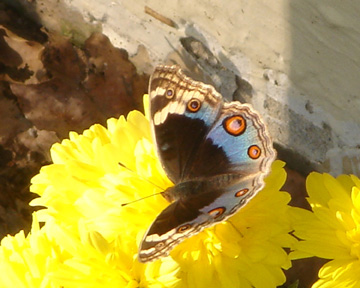Gardening for wildlife
Gardening for wildlife
-Susan Sharma
Organic gardening attracts wildlife.
Wildlife is all around us and they can entertain and educate us if only we stop to look around. When we make friends with bees, butterflies ans birds not to speak of frogs, snakes ans lizards, a whole new world opens up.
Whether you have a small city garden, a big country one, a farm or a high-rise balcony - there is so much that can be done to support the wildlife all around us.

Blue pansy butterfly on chrysanthemum flower
In today's world where we are worried about pollution in air, water and soil, is it not high time that we started paying some attention to all these? It is good to make a beginning with our own house garden which we are in control of.
A study by Centre for Science and Environment has shown that as per an average diet of daily intake of various foods, we will be exceeding the ADI (Acceptable Daily Intake) of pesticides by approximately 400%! Isn't it time we paid more attention to what goes
into our food? And what better way to learn than grow some vegetables in our garden.
Managing Pests without Pesticides
Pesticides being used become ineffective in no time since such a use allows for insects to be selected for genetic resistance rather than controlling them. The alternative now being marketed, which has much serious consequences, are the genetically
engineered crops that are released as well as lined up for release.
Biodynamic farming and permaculture
Under Non-Pesticidal Management, the primary focus is on replacing the external inputs with the local knowledge, management skills, labour and effective utilisation of natural products and processes that are locally available. The farmers understand the pest
biology and life cycle and modify crop management practices to keep the insect population under check, and stop insects from reaching a pest status.
In the four stages of the life cycle, insects damage the crop only in one stage (larval stage in most of the cases) — at least two of the stages are immobile (egg and pupa). The adult stage will not be on the crop. There are several options available to control
them at each of the stages, mostly using local resources.
Many of the insects that live in our gardens are beneficial. They creep around our plants and gobble up aphids and caterpillars and the like. Therefore, it stands to reason that if we increase the number of beneficial insects in our gardens, then we will decrease
the pests.

A wasp nest-wasps are most beneficial in reducing pests
If you have to use pesticide, use a natural pesticide like "neem oil". Neem oil is commercially available in good garden stores. Other natural fungicides are vinegar, red chillies, a freshly made chutney of shareefa(custard apple) leaves etc.
We want to find inspirational stories of families who have turned their small patch into wildlife friendly spaces.
The idea is to find amazing wildilfe gardeners, so that the others can follow their lead and make their gardens wildlife friendly too. Tell us how you control pests and grow healthy vegetables with no chemicals. If you’ve put in a pond, built a rockery,
assembled a log pile or done anything whatsoever to discover the amazing wildlife living on your doorstep, your story could help inspire other families to do the same. If you want to share your experiences, then please contact susan_sharma@hotmail.com.
We hope to keep this new series on 'gardening for wildlife' going with experiences of our members. Please do write -in.
|